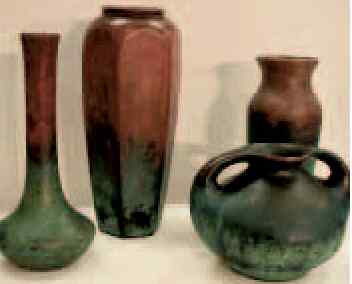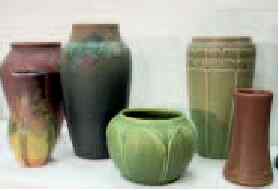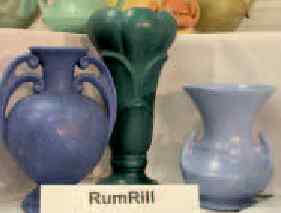|
©1999-2015 |
The following article appeared in WPA Press, Vol. 18, Fall 2003
2003 Show & Sale Recap The Wisconsin Pottery Association recently held it’s annual fundraiser, known by club members as the “Show and Sale”. The big event was held at Madison’s Alliant Center on August 23, 2003 and featured, as an educational exhibit, “Ohio Spectrum”, a collection of pottery from various early Ohio firms. The following is the text used in the brochure that accompanied this fabulous exhibit. As much as its abundant coal and clay, Ohio’s central location contributed to making it the country¹s leading clay products manufacturer. When New York’s Erie canal was built in 1817, it opened Ohio to eastern seaboard (and international) markets via Lake Erie. In 1825 development of an Ohio canal/river system with a north-south orientation began, providing central and southern Ohio towns equal access to the lucrative markets. By the 1840s there were so many clay products manufacturers in Ohio that some firms engaged in price fixing. Companies formed alliances, dividing markets among themselves to keep prices from falling. Railroads began at this same time. Ohio towns not on the canal system quickly invested in railways. By 1860, four east-west railways crossed Ohio, and the state had more miles of track than any other in the Union. After the Civil War, Ohio continually ranked at or near the top of the nation’s brick manufacturers and Zanesville billed itself as the largest tile manufacturing center in the world. Art Pottery in the United States was spawned by the 1876 Philadelphia Centennial Exhibition. Displays of Asian and European pottery and porcelain inspired a revolution in American ceramic design, much of which occurred in Ohio. This exhibit demonstrates the progression of American Art Pottery—and artware— from the 1880s through the mid-20th century by showing products made by Ohio firms (shown here in bold). America’s earliest Art Pottery is represented here by Rookwood’s Limoge-type ware and its underglaze-decorated Standard ware. The Standard ware glaze was later appropriated by Weller, J. W. McCoy, Owens, and Roseville, among others. Today we are showing variations of that glazing technique as it was used by these competing firms. Some companies that began their history manufacturing utilitarian ware, Roseville and Weller, for example, switched their focus to Art Pottery at the end of the 19th century and maintained production into the mid-20th century. Brush, Hull, Nelson McCoy, and Zanesville Stoneware did better, surviving until recent times. Robinson- Ransbottom did best of all—it’s still in business. The companies that made it through the Great Depression of the 1930s mostly consolidated into large-scale operations. Companies like Cowan, RumRill, and Burley and Winter, did not, and they didn’t survive. The exception was small studios, like those of potter Chester Nicodemus and metalworker Charles Clewell; both survived the depression and the bigger-isbetter trend. Some firms—like Chic, Gonder Sebring, and Shawnee—began at the end of the depression, capitalizing on the lack of imports during World War II. The resumption of cheap imports after the war killed off these same firms. The following is a list of companies in this exhibit, along with their places and dates of operation. Sources vary on these facts, and when they do, we have generally sided with the most recently published data. Companies represented in the exhibit: Brush (Brush-McCoy) Burley and Winter
Cowan Gonder Ceramic Arts Hull McCoy Nicodemus Owens Peters and Reed Robinson Ransbottom
Roseville Pottery Company
Shawnee Pottery Company Spaulding China Company
Zanesville Stoneware Company Thanks to Nicol Knappen for preparing, and for sharing this information with the WPA Press ! And thanks to Tim Zinkgraf for the photographs, which are placed here, following the pottery each represents. - K. Kenefick, Ed. Related Pages:
|













